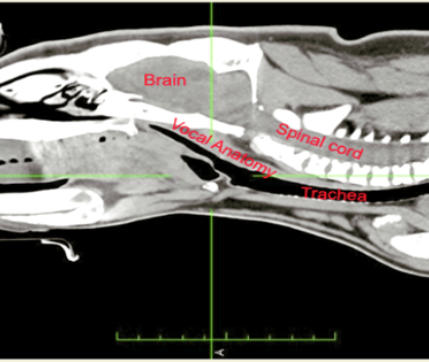

Do Hairy-nosed Wombats talk to each other?
The University of Queensland in collaboration with the
University of Vienna and Australian Animals Care and
Education, have recently commenced a project to
determine the importance of vocal communication in
wombats.
The project, which is supported by the Wombat
Foundation, aims to investigate the behavioural ecology of
the Southern Hairy-nosed wombat with the ultimate aim
of relating these findings to the highly endangered
Northern Hairy-nosed Wombat.
The general objective of the project is to determine the
biological information encoded by specific acoustic
components of wombat vocalizations, and then use
systematic playback experiments to investigate the
functional roles of these acoustic cues in different social
and reproductive contexts.
Although we are in the early stages of the research, the
results of the study appear to suggest that wombats have a
characteristic vocal pattern that represents a signature
for the individual animal, in much the same way that a
human voice is distinctive. We have included a short wav
file vocal recording of one of our female wombats know as
Bella which was taken when she was protesting about
being approached to be recorded.
Parallel to these vocal observations has been an
assessment of the vocal anatomy of the male and female
using CAT scan technology at the University of
Queensland Veterinary School, UQ Gatton.
This amazing instrument takes multiple cross-section
radiographs of the whole body of the wombat that can
then be reassembled to produce a three dimensional
image. You can see an image of our female wombat called
Lolly, in which the CAT scan has revealed the skin,
respiratory system, some of the digestive tract and the
underlying skeleton


In the more conventionl 2d CAT scan
image below, you can see a section
through vocal cord anatomy of a male
wombat know as KIAL
As part of current project we are trying to link the vocalisations of the wombats to
their specific vocal cord anatomy. Our initial investigations to date have revealed a
difference in anatomy between male and female wombats, which we believe
potentially reflects a difference in their respective vocal repertoires. Over the next
3 months we will be gathering more vocal recordings of the wombats at the
Australian Animals Care and Education facility at Marlborough in order to
determine the specific context of the sounds produced by male and female
wombats. Using high quality speakers, we will play these sounds back to the
wombat in attempt to determine their communicative value
Stephen Johnston BSc (Zool) Hons PhD
Chief Investigator Reproductive Zoologist
Wildlife Biology Unit Faculty of Science
The University of Queensland
Science




In the more conventionl 2d CAT scan
image below, you can see a section
through vocal cord anatomy of a male
wombat know as KIAL
As part of current project we are trying to link the
vocalisations of the wombats to their specific vocal
cord anatomy. Our initial investigations to date have
revealed a difference in anatomy between male and
female wombats, which we believe potentially
reflects a difference in their respective vocal
repertoires. Over the next 3 months we will be
gathering more vocal recordings of the wombats at
the Australian Animals Care and Education facility at
Marlborough in order to determine the specific
context of the sounds produced by male and female
wombats. Using high quality speakers, we will play
these sounds back to the wombat in attempt to
determine their communicative value
Stephen Johnston BSc (Zool) Hons PhD
Chief Investigator Reproductive Zoologist
Wildlife Biology Unit Faculty of Science
The University of Queensland
Science
Do Hairy-nosed Wombats talk to
each other?
The University of Queensland in
collaboration with the University of
Vienna and Australian Animals
Care and Education, have recently
commenced a project to determine
the importance of vocal
communication in wombats.
The project, which is supported by
the Wombat Foundation, aims to
investigate the behavioural ecology
of the Southern Hairy-nosed
wombat with the ultimate aim of
relating these findings to the highly
endangered Northern Hairy-nosed
Wombat.
The general objective of the project
is to determine the biological
information encoded by specific
acoustic components of wombat
vocalizations, and then use
systematic playback experiments to
investigate the functional roles of
these acoustic cues in different
social and reproductive contexts.
Although we are in the early stages
of the research, the results of the
study appear to suggest that
wombats have a characteristic vocal
pattern that represents a signature
for the individual animal, in much
the same way that a human voice is
distinctive. We have included a
short wav file vocal recording of one
of our female wombats know as
Bella which was taken when she was
protesting about being approached
to be recorded.
Parallel to these vocal observations
has been an assessment of the vocal
anatomy of the male and female
using CAT scan technology at the
University of Queensland
Veterinary School, UQ Gatton.
This amazing instrument takes
multiple cross-section radiographs
of the whole body of the wombat
that can then be reassembled to
produce a three dimensional image.
You can see an image of our female
wombat called Lolly, in which the
CAT scan has revealed the skin,
respiratory system, some of the
digestive tract and the underlying
skeleton


















































